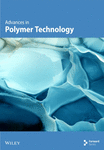Rotational molding of liquid plastic systems: An assessment of material moldability
Abstract
This article describes the outcome of an investigation into the rotational molding of liquid plastics. Three liquid plastic systems were assessed: (1) a nylon block copolymer, Nyrim; (2) two grades of polyvinyl chloride plastisol, Acrol DS409A and Hydro PRC/65/0307/9270; and (3) two grades of polyurethane, Hyperlast 7850506 and Hyperlast 7853184. Initially, resin flow behavior was assessed in the uniaxial rotation mode. Characteristic flow regimes were identified for each liquid. The onset and duration of a particular regime depends on the initial viscosity of the liquid, its repooling behavior, and its curing profile. For a particular material, the finished part appearance (hydrocysts, bubbles, fault-free, etc.) depends on the mold rotation speed and material shot size, as well as mold geometry. A fault-free operating criterion is presented for the uniaxial rotation of liquid plastics. Uniaxial rotation tests are useful for predicting general trends in biaxial rotation of liquid plastics. The most important factors in determining the state of a finished part made by biaxial rotation are: (i) resin initial viscosity and curing profile; (ii) mold rotation speed; (iii) shot size; and (iv) mold shape. An ideal viscosity profile for a rotational molding liquid resin, based on information gained from both uniaxial and biaxial rotation tests, is proposed. The rheology of each material was also examined and the profiles observed were related to the molding behavior of each liquid. © 1996 John Wiley & Sons, Inc.




